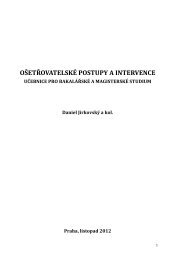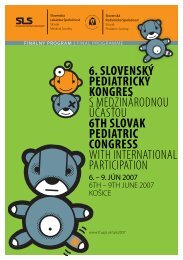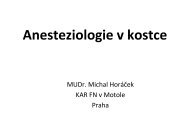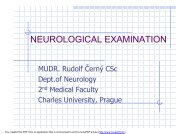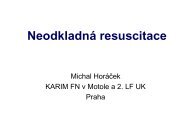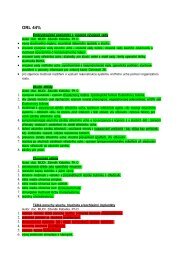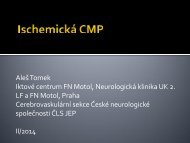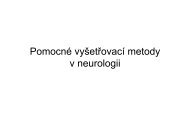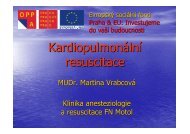Epilepsy and Epileptic Seizures
Epilepsy and Epileptic Seizures
Epilepsy and Epileptic Seizures
Create successful ePaper yourself
Turn your PDF publications into a flip-book with our unique Google optimized e-Paper software.
<strong>Epilepsy</strong> <strong>and</strong> <strong>Epileptic</strong> <strong>Seizures</strong><br />
Petr Marusič<br />
Dpt. of Neurology<br />
Charles University in Prague<br />
2nd Faculty of Medicine<br />
Motol University Hospital
<strong>Epilepsy</strong><br />
• Spontaneously recurring epileptic seizures<br />
• One of most common CNS diseases<br />
• Prevalence: 0.5-1%<br />
– Czech Rep. = 70 000 patients<br />
• Incidence: 50 newly diagnosed/100 000/y<br />
– Czech Rep. = 5000/year
<strong>Epileptic</strong> seizure<br />
• Symptom of brain functional impairment<br />
– acute<br />
– chronic<br />
• Usually short transient change in clinical<br />
status caused by pathological<br />
– increase in neuronal excitation<br />
– decrease in neuronal inhibition<br />
– neuronal hypersynchrony
Diagnosis<br />
Steps<br />
• Differentiation of nonepileptic events<br />
• Seizure classification<br />
• <strong>Epilepsy</strong> classification<br />
– Etiology
Nonepileptic Events<br />
• Somatic<br />
– SYNCOPE<br />
– TIA, migraine, transient global amnesia, metabolic<br />
disorders<br />
• Psychogenic<br />
– DISSOCIATIVE („Pseudoseizures“)<br />
– Panic attack
Syncope<br />
Differentiation from <strong>Epileptic</strong> Seizure<br />
• Onset<br />
• Autonomic signs<br />
• Injury<br />
• Incontinence<br />
• Motor activity – convulsive syncope
Syncope Seizure<br />
Body position Vertical<br />
Independent<br />
Prevalence Awake Awake/Sleep<br />
Color Pale Cyanotic<br />
Aura Non-specific Specific<br />
Confusion Short Prolonged<br />
Automatisms Absent<br />
May occur<br />
EEG Normal Abnormal
Psychogenic <strong>Epileptic</strong><br />
Age of onset Younger Whenever<br />
Provocation Situation Different<br />
Duration Often >5 min. Usually
Hyperventilation Attacks<br />
• Provoked hyperventilation<br />
– Pain, anxiety, psychogenic component<br />
• Mouth <strong>and</strong> h<strong>and</strong>s paresthesia<br />
• H<strong>and</strong>s <strong>and</strong> feet spasm - tetany<br />
• Tx - verbal, drugs<br />
– Breathing into plastic or paper bag<br />
• Other causes of tetany<br />
– Ca, Mg
<strong>Epileptic</strong> Seizure<br />
• Acute symptomatic (provoked) – aetiology<br />
– Cerebral – head injury, stroke, mass lesion - tumor,<br />
encephalitis<br />
– Extracerebral – metabolic disorder, electrolyte<br />
dysbalance, drugs, alcohol/drugs withdrawal<br />
• Recurrent unprovoked - EPILEPSY<br />
• Isolated unprovoked - EPILEPSY
Classification<br />
• SEIZURES<br />
• EPILEPSIES<br />
• Type<br />
– Description<br />
• EEG (interictal)<br />
• Overall clinical<br />
impression<br />
• History<br />
• Seizure type<br />
• EEG<br />
• Imaging
Seizure Classification<br />
– ILAE 1981<br />
• Simple Partial (SPS)<br />
– Consciousness fully preserved<br />
• Complex Partial (CPS)<br />
– Consciousness impaired<br />
• Generalized<br />
– Primary or secondary
Seizure Evolution<br />
Simplex Partial Complex Partial Generalized<br />
• Postparoxysmal period – alteration
Generalized <strong>Seizures</strong><br />
• Absence<br />
• Myoclonic<br />
• Clonic<br />
• Tonic<br />
• Tonic-clonic (GTCS)<br />
• Atonic
Classification<br />
• SEIZURES<br />
• EPILEPSIES<br />
• Type<br />
– Description<br />
• EEG (interictal)<br />
• Overall clinical<br />
impression<br />
• History<br />
• Seizure type<br />
• EEG<br />
• Imaging
Classification<br />
• SEIZURES<br />
• EPILEPSIES<br />
• Type<br />
• EEG<br />
– Description<br />
• Overall clinical<br />
impression<br />
• History<br />
• Seizure type<br />
• EEG<br />
• Imaging
Classification of Epilepsies <strong>and</strong><br />
– ILAE 1989<br />
<strong>Epileptic</strong> Syndromes<br />
• Focal, Localization-related<br />
– Focal brain disorder<br />
• Generalized<br />
– Diffuse disorder
Classification of Epilepsies <strong>and</strong><br />
<strong>Epileptic</strong> Syndromes<br />
• Idiopathic (genetic)<br />
• Symptomatic (structural or metabolic)<br />
• Cryptogenic (unknown aetiology)
Prophylaxis<br />
• No prove of prophylactic effect of antiepileptic<br />
drugs on development of posttraumatic<br />
epilepsy<br />
• Temkin NR, et al. Epilepsia. 1997<br />
• Similar results for other symptomatic<br />
epilepsies
Therapy<br />
• Life style<br />
– Elimination of risk<br />
– Elimination of triggers<br />
• Antiepileptic drugs (AEDs)
Therapy<br />
• Choice of AED<br />
• Titration<br />
• Outcome – efficacy<br />
– <strong>Epilepsy</strong> type dependent<br />
– 70% seizure free<br />
– 30% drug resistant (refractory)<br />
• Discontinuation
Antiepileptic Drugs<br />
• 1. generation = old AEDs<br />
– phenobarbital, primidone, phenytoin, etosuximide<br />
• 2. generation<br />
– carbamazepine, valproate<br />
• 3. generation = new AEDs<br />
– lamotrigine, levetiracetam … <strong>and</strong> others
Choice of AED<br />
• Efficacy<br />
– Type of seizure/syndrome<br />
• Side-effect profile<br />
– Personal history<br />
– Physical status<br />
– Anticipation
Emergency<br />
• 1st seizure<br />
• Cluster of seizures<br />
• Status epilepticus
First Aid<br />
• During seizure<br />
– simple partial<br />
– complex partial<br />
– generalized convulsive<br />
• Following the seizure
Status <strong>Epileptic</strong>us<br />
• Definition<br />
– Historical<br />
– New<br />
• seizure activity lasting 30 minutes without pt. regaining<br />
full consciousness between seizures<br />
• seizure lasting longer than 5 minutes = low chance for<br />
spontaneous termination<br />
• 2nd seizure within 30 minutes without regaining full<br />
consciousness between seizures
Treatment<br />
• Airways<br />
– Obstruction<br />
– Head position<br />
• Oxygen<br />
• IV line - laboratory testing<br />
– Blood sugar<br />
• Vital signs monitoring
Therapy<br />
• Diazepam 10-20 mg IV or rectal<br />
– Repeat if effective after 10-15 minutes<br />
– Hypotension, respiratory failure<br />
• Alternatively<br />
– Midazolam (Dormicum) 5-15 mg IV or IM<br />
– Clonazepam (Rivotril) 1-2 mg IV<br />
• Phentyoin 15-20 mg/kg IV = +/- 4 amp.<br />
– Slow saturation ! - 50 mg/min - ECG monitor
<strong>Epilepsy</strong> <strong>and</strong> Pregnancy<br />
• Higher risk for mother <strong>and</strong> child (fetus)<br />
– <strong>Seizures</strong><br />
– Teratogenicity<br />
• Most epilepsy women have<br />
– Normal pregnancy <strong>and</strong> delivery<br />
– No change in seizure frequency<br />
• Breast feeding generally not contraindicated
Psychiatric Comorbidities <strong>and</strong><br />
Psychosocial Aspects<br />
• Psychiatric comorbidity<br />
– Anxiety, depression, psychosis<br />
• Stigma of having epilepsy<br />
• Employment issues<br />
• Driving<br />
• Therapeutic outcome<br />
– Seizure frequency<br />
– Seizure-free period



